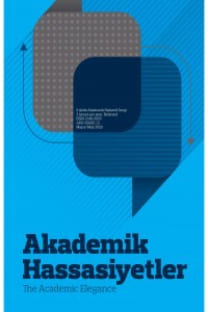TCMB İMALAT SANAYİ SEKTÖREL BİLANÇOLARI KULLANILARAK İKTİSADİ PARAMETRELERİN SERMAYE YAPISINA ETKİSİ ÜZERİNE BİR UYGULAMA
Sermaye yapısı, finans literatüründe büyük
yere sahiptir. Bunun sebebi, sermaye yapısının sermaye maliyetini,
sermaye bütçelemesini ve firma değerini etkilemesidir.
Firmanın varlıklarını nasıl finanse edeceğini tespit
etmesi önemlidir. Dış kaynakların
veya iç kaynakların hangisinin kullanılacağına karar vermelidir. Tüm bu
kararlar, firmaların sermaye yapısı kararlarıyla bağlantılıdır. Sermaye
yapısını etkileyen unsurlar firmaya özgü, endüstriye
özgü, ülkeye özgü veya sektöre özgü olarak
kategorize edilebilir. Bu çalışmada amaç, sermaye
yapısı üzerindeki iktisadi etkiyi sektörel bazda açıklamaktır. Ayrıca
çalışma, her bir sektörde ekonomik parametrelerin etkisini ayrı ayrı
değerlendiren bir tablo oluşturması açısından önemlidir. Bu amaç doğrultusunda, 15 yıllık 2002-2016 yıllarını kapsayan Türkiye
Cumhuriyet Merkez Bankası (TCMB) imalat sanayi sektörleri finansal verileri incelenmiştir.
Bu veriler için regresyon analizi kullanılmıştır. Bağımlı değişkenin tek
olmasından dolayı, basit doğrusal regresyon yöntemiyle analiz edilmiştir. Elde
edilen bulgulara göre, 8 sektörün büyük kısmının sermaye yapılarını gayri safi
yurtiçi hasıla (GSYH) ve faiz istatistiksel olarak anlamlı bir şekilde
etkilerken, döviz kuru sadece 2 sektörü ve enflasyon tek sektörü istatistiksel
olarak anlamlı şekilde etkilemektedir.
Anahtar Kelimeler:
İktisadi Parametreler, Sermaye Yapısı, TCMB
AN APPLICATION ON EFFECTS OF ECONOMIC PARAMETERS ON CAPITAL STRUCTURE USING CBRT MANUFACTURING INDUSTRY SECTORAL BALANCE SHEETS
The capital structure has a important place in the
finance literature. The reason of this because capital structure affects
capital cost, capital budgeting and firm value. It
is substantial for a company to detect how to finance its assets. it should decide
which use external sources or internal sources. All these verdict are linked
with capital structure choices of firms. The elements affecting capital
structure can be categorized as firm specific, industry specific, country
specific or sector specific. In this study, our focus is on sector specific
factors. The purpose of
this study is to explain on a sectoral basis the economic impact on capital
structure. For this purpose, the financial data of Central Bank of the Turkish
Republic (CBRT)
manufacturing industry sectors of 2002-2016 were analyzed by simple linear
regression analysis method. According to
the findings, the capital structure of most of the 8 sectors has a
statistically significant effect on gross domestic product (GDP) and interest rate, while the exchange rate affects only 2 sectors and
the inflation single sector statistically significantly.
Keywords:
Capital Structure, CBRT,
___
- Aghapour, K. (2016). Mali ve İktisadi Değişkenlerin BIST’te İşlem Gören Şirketlerin Sermaye Yapısı Üzerindeki Etkileri, Yayımlanmamış Yüksek Lisans Tezi, Atatürk Üniversitesi Sosyal Bilimler Enstitüsü, Erzurum.
- Akgüç, Ö. (1998). Finansal Yönetim (Yenilenmiş 7. Baskı). İstanbul: Avcıol Basım Yayın, 481.
- Aksöyek, İ., Yalçıner, K. (2011). Çözümlü Problemleriyle Finansal Yönetim. İstanbul Bilgi Üniversitesi Yayınları, 249
- Arestis, P., Luintel, A., Luintel, K. (2004). “Does Financial Structure Matter?”, Economics Working Paper Archive, The Levy Economics Institute of Bard College.
- Başaran, Ü. (2008). İMKB’de İşlem Gören Otomotiv ve Otomotiv Yan Sanayi İşletmelerinin Sermaye Yapısı Kararlarını Etkileyen Faktörlerin Analizi, Yayımlanmamış Yüksek Lisans Tezi, Zonguldak Karaelmas Üniversitesi Sosyal Bilimler Enstitüsü, Zonguldak.
- Bokpin, G. A. (2009). Macroeconomic Development and Capital Structure Decisions of Firms: Evidence from Emerging Market Economies. Studies in Economics and Finance.
- Ceylan, A., Korkmaz, T. (2013). İşletmelerde Finansal Yönetim (Gözden Geçirilmiş 13. Basım). Ekin Basın Yayın Dağıtım, 238, 280-281.
- Fıratoğlu, B. (2005). Şirketlerin Sermaye Yapısını Etkileyen Faktörler ve Kriz Dönemlerinde Şirket Davranışlarında Meydana Gelen Değişiklikler. Sermaye Piyasası Kurulu Araştırma Raporu.
- Korajczyk, R. A., Levy, A. (2003). Capital Structure Choice: Macroeconomic Conditions and Financial Constraints. Journal of Financial Economics, 68, 75-80.
- Mak, M. (2013). The Impact of Firm Specific Factors on Capital Structure: Empirial Evidence from Turkey, Yayımlanmamış Doktora Tezi, Marmara Üniversitesi Sosyal Bilimler Enstitüsü, İstanbul.
- Okka, O. (2009). Finansal Yönetim (3. Baskı). Konya: Nobel Yayın Dağıtım, 426.
- Orhan, O. Z., Erdoğan, S. (2006). İktisada Giriş (Genişletilmiş ve Gözden Geçirilmiş 2. Baskı). Avcı Ofset, 544.
- Zein, A. M. (2016). Can Macroeconomic Factors Explain the Choice of Capital Structure? A study of listed non-financial firms in Sweden. Master Thesis. Uppsala University Department of Business Studies, Sweden
- ISSN: 2148-5933
- Yayın Aralığı: Yılda 3 Sayı
- Başlangıç: 2014
- Yayıncı: A Kitap
Sayıdaki Diğer Makaleler
XXI. YÜZYILIN EŞİĞİNDE DEMOKRASİ VE KALKINMA
TÜRK MİLLİYETÇİLİĞİ VE KEMALİZM MESELESİ: HEGEMONYA, ASİMİLASYON, MÜCADELE
PERSONEL GÜÇLENDİRME İLE ÖRGÜTSEL BAĞLILIK ALGISI VE İLİŞKİSİ: LİMAN İŞLETMESİ ÇALIŞANLARI ÖRNEĞİ
Tunay SEVER ELÜSTÜN, İlyas SÖZEN
ULUSLARARASI ÖRGÜTLERİN MEŞRULUĞU ÜZERİNE: DE FACTO OTORİTE
MAX HORKHEIMER VE THEODOR W. ADORNO’DA MODERN İNSAN VE TÜKETİM İDEOLOJİSİ
Fatma Begüm ÖZEL, Alper MUMYAKMAZ
DOĞRUDAN YABANCI YATIRIMLAR, TİCARİ SERBESTLEŞME VE İKTİSADİ BÜYÜME: TÜRKİYE ÖRNEĞİ
TÜRKÇÜ-TURANCI MİLLİYETÇİLİĞİN DÜŞÜNSEL TEMELLERİ ÜZERİNE BİR İNCELEME
KOOPERATİF İŞLETMELER VE İLİŞKİSEL PAZARLAMA: BİR MODEL YAKLAŞIMI
